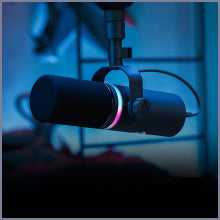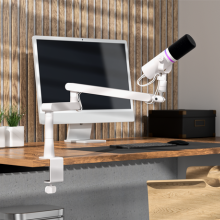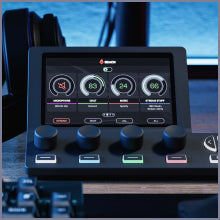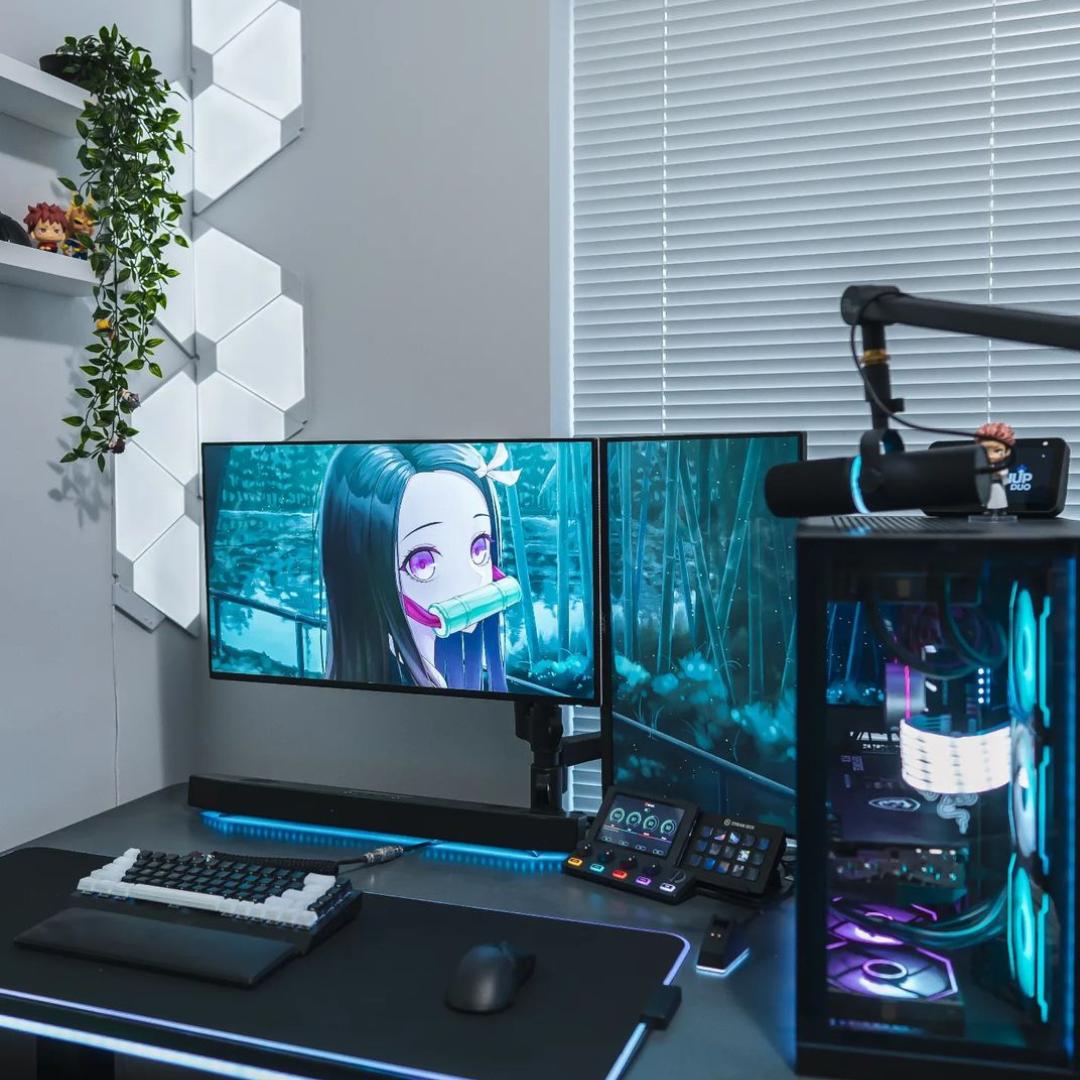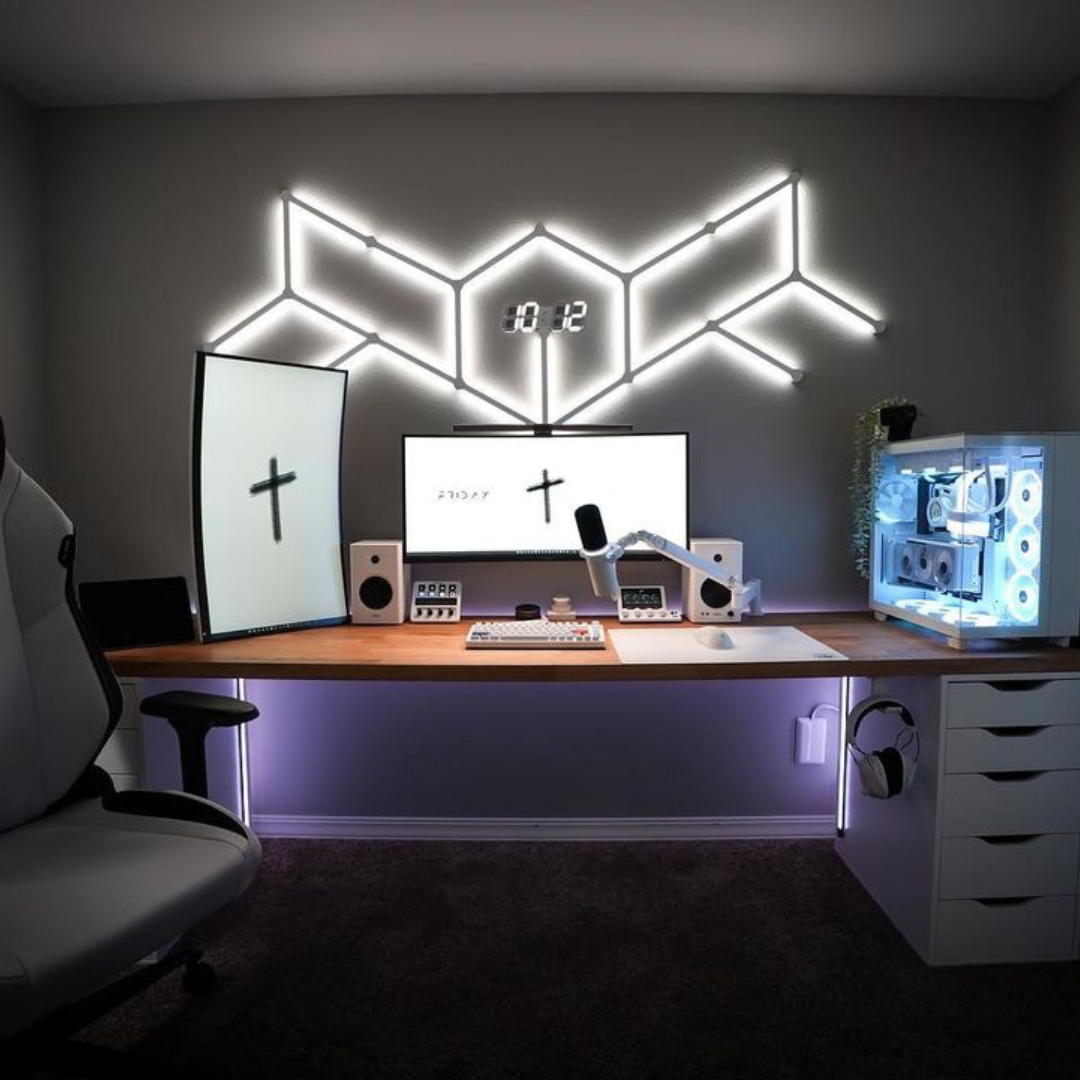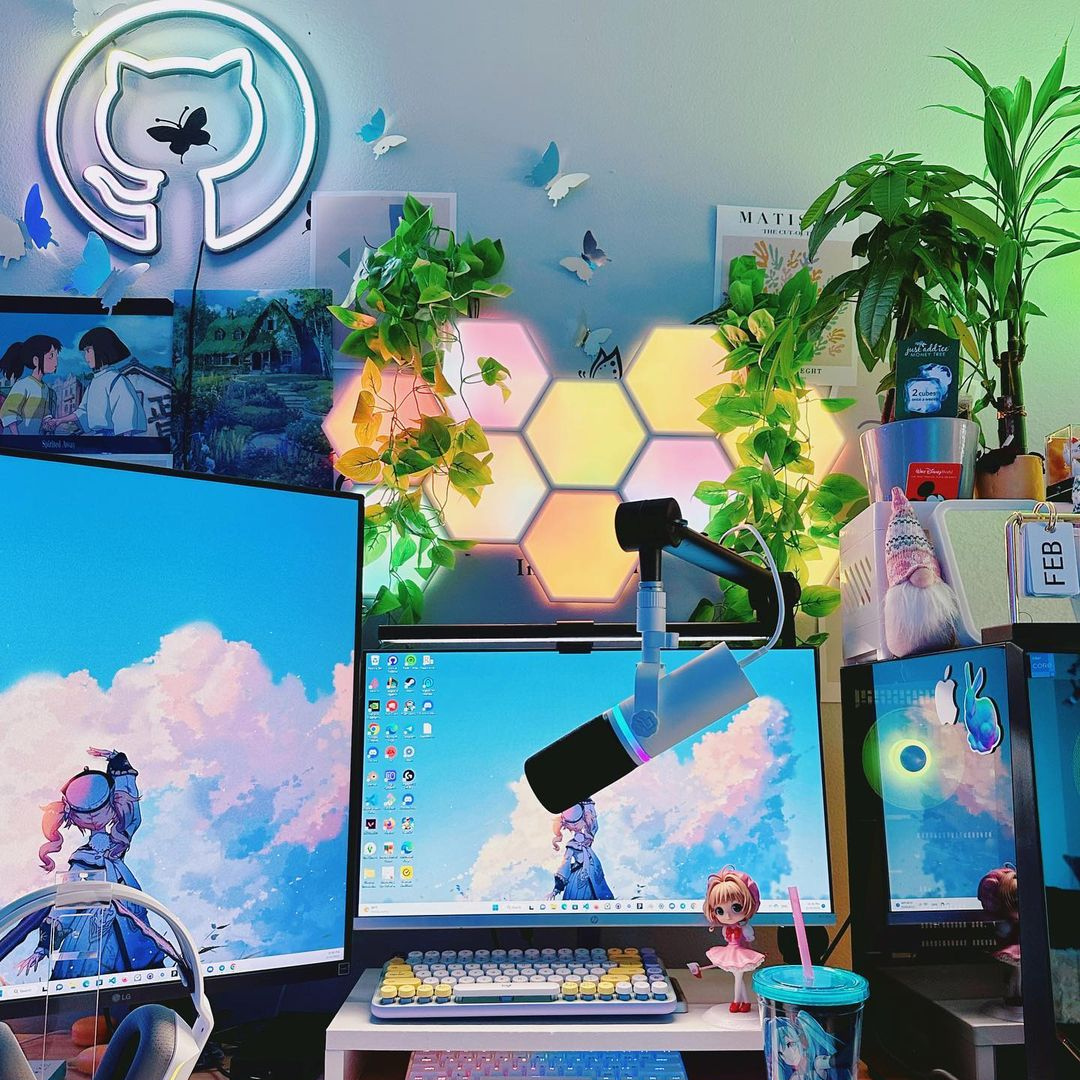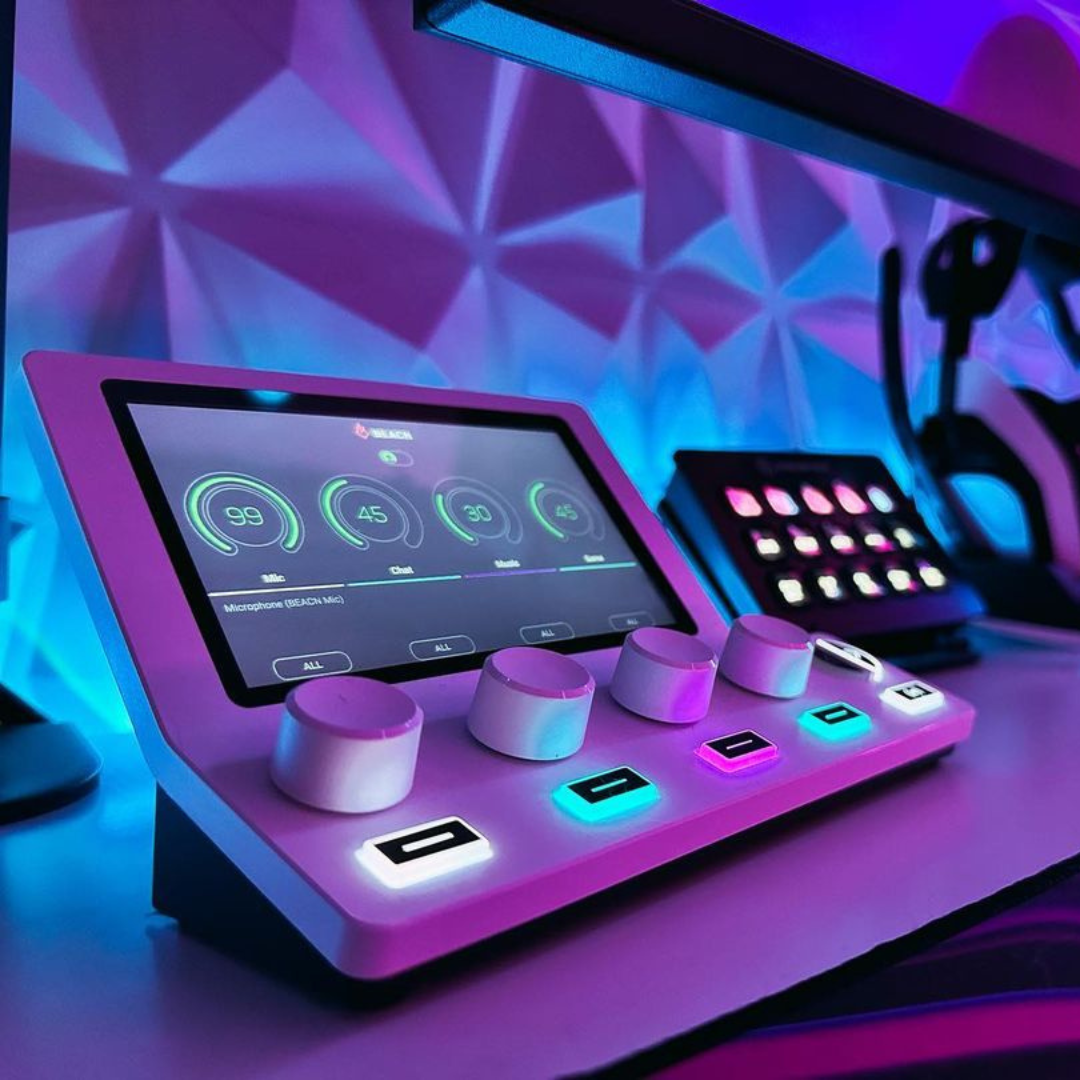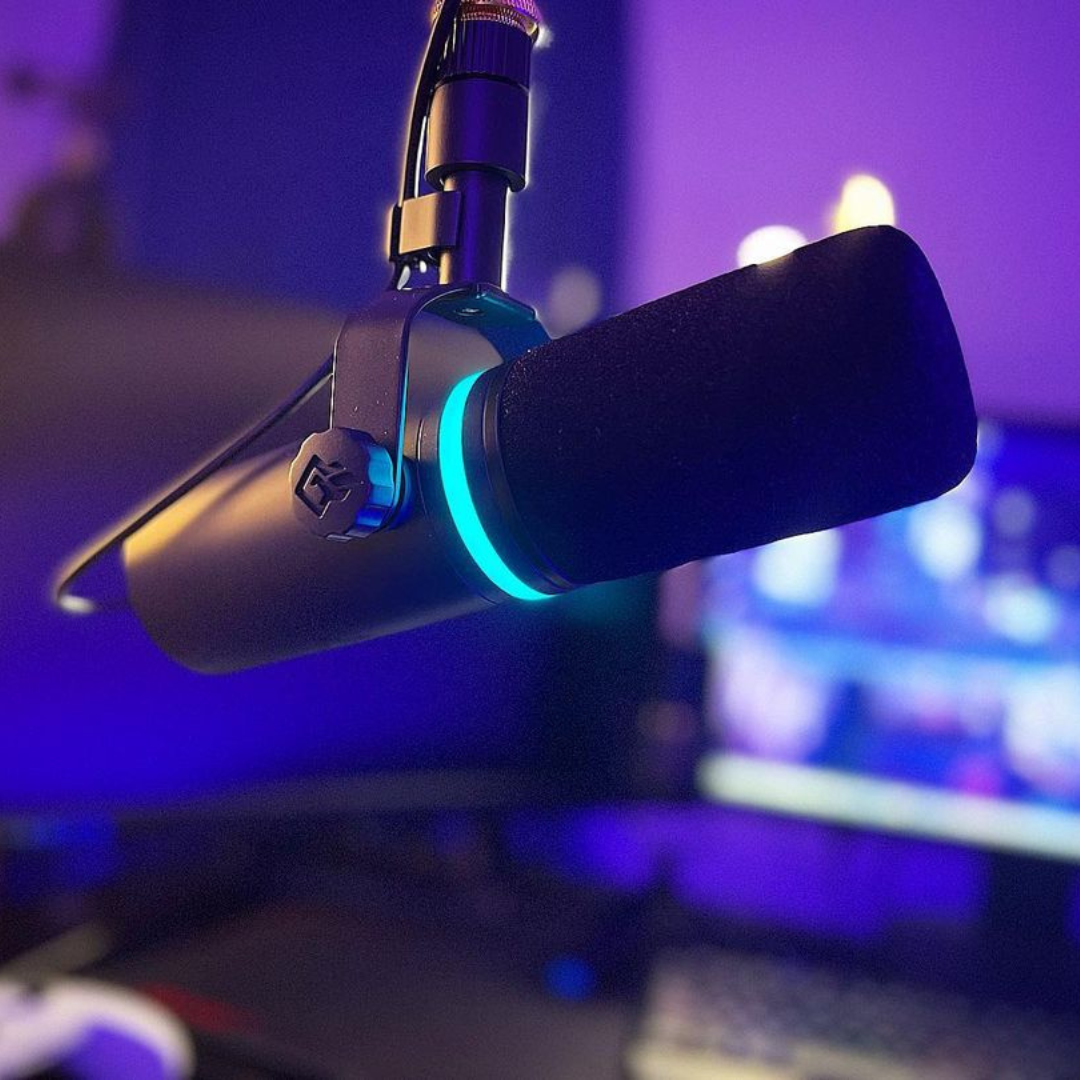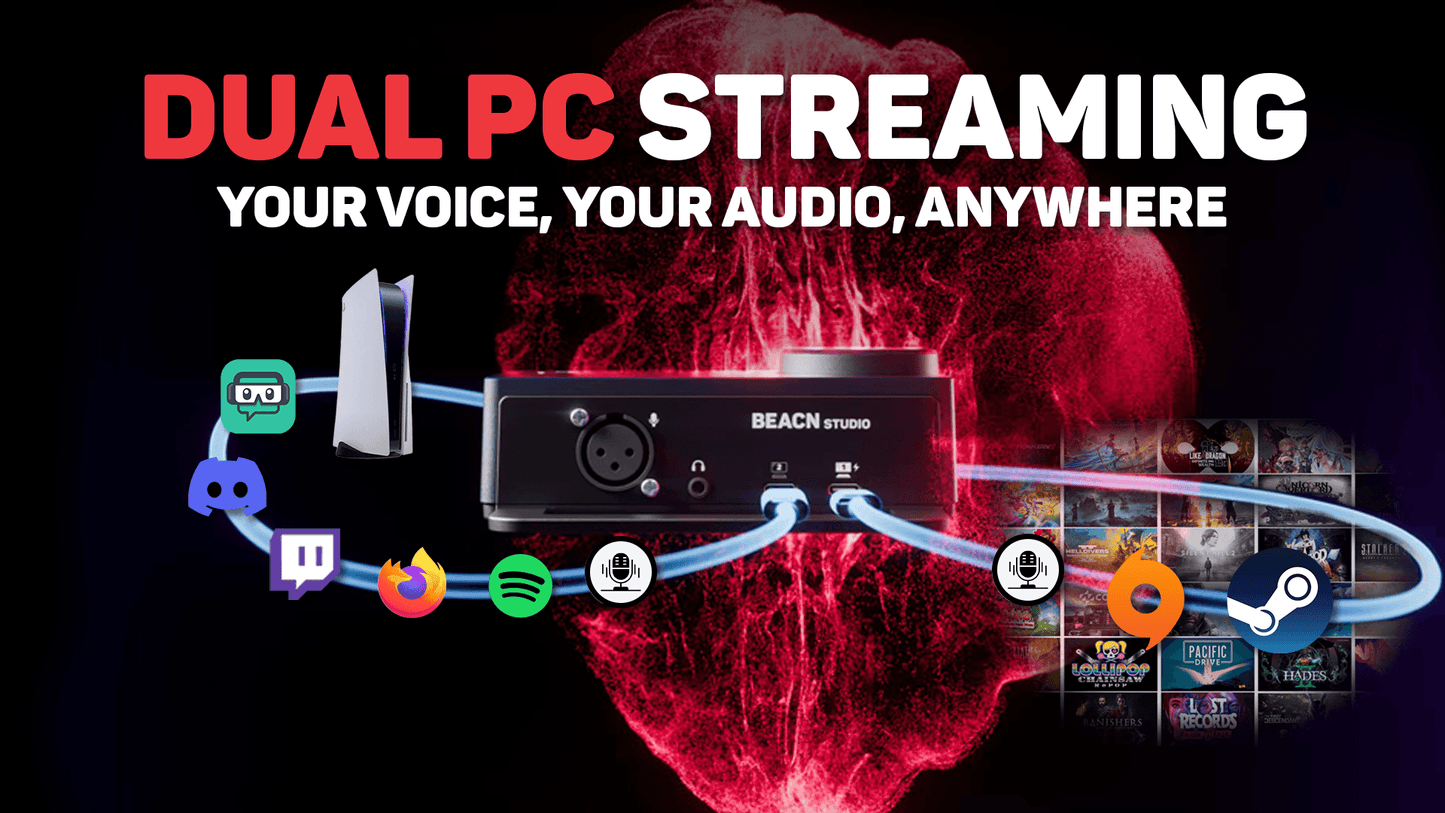
This site is protected by hCaptcha and the hCaptcha Privacy Policy and Terms of Service apply.
DESCRIPTION
SPECIFICATIONS

Industry-First Dual PC Audio Control
We’ve created our own BEACN Link App* that lives on your second PC and allows you to drag & drop apps to route audio on your streaming PC from your gaming PC remotely! Dual PC streaming just took a huge leap forward.
*BEACN Link App for PC only at this time

Become A Mixing Powerhouse
Seamlessly connect multiple computers, consoles or other digital audio devices like a phone to your BEACN Studio and bring that audio directly into BEACN App for mixing, submixing and management with dual USB-C connection.
Need a music free VOD track? No problem.
Want your game sounds loud for you and not so much for your viewers? Done.
Need to bring in your PS5 game sounds and send back your amazing mic to in-game chat? Easy.
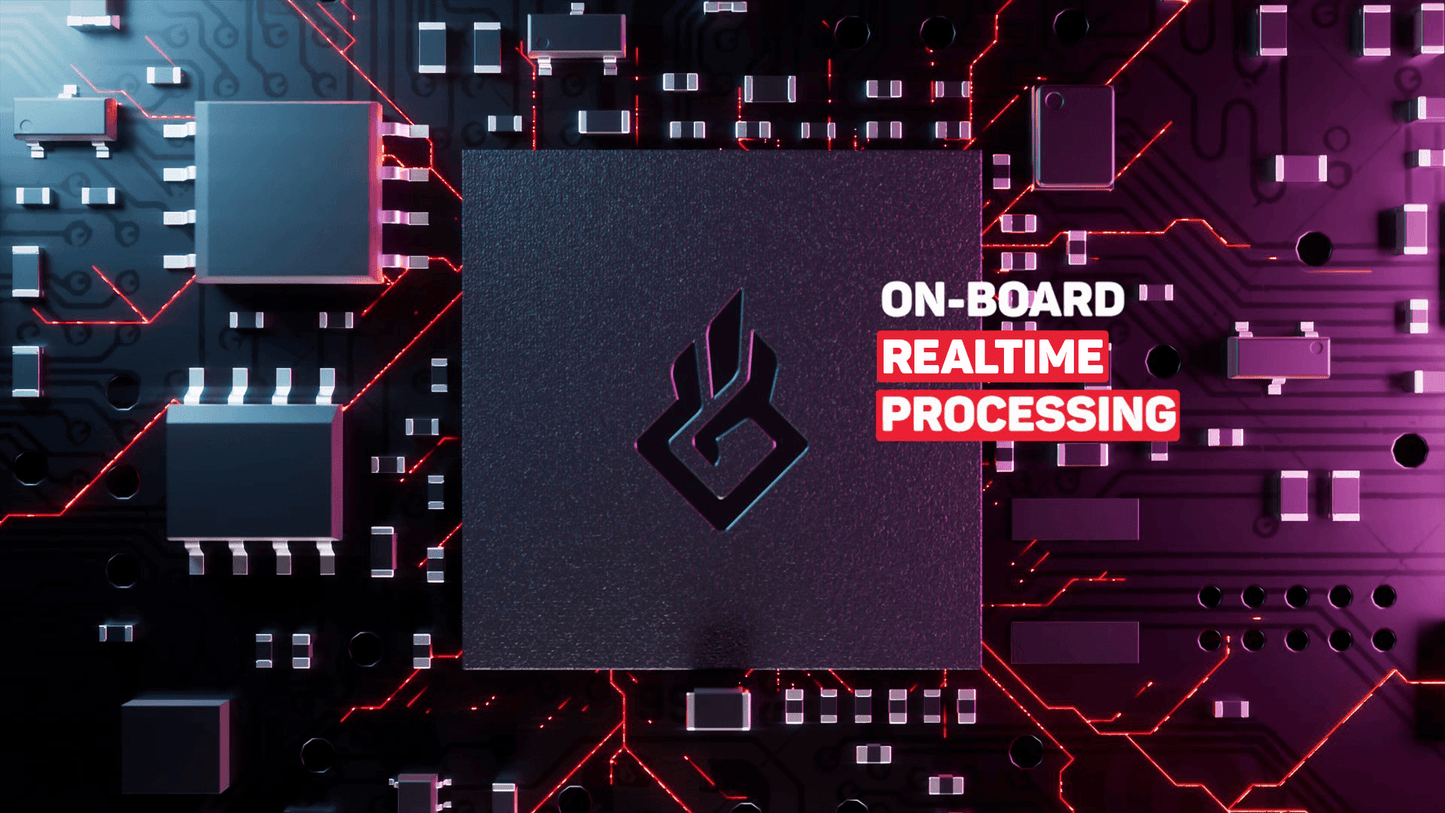
Onboard Real-Time Processing
Give your voice special treatment by customizing BEACN Studio's internal broadcast effects with the BEACN App. We designed the BEACN App from the ground up to take professional tools and make them accessible with helpful presets and tutorials. Streamers, podcasters and content creators will benefit from a full 8-band EQ, compressor, expander/gate, exciter, de-esser, bass enhance, and more. Dial in the best microphone sound for your voice anytime you want. The result? The best voice quality that reflects exactly who you are.
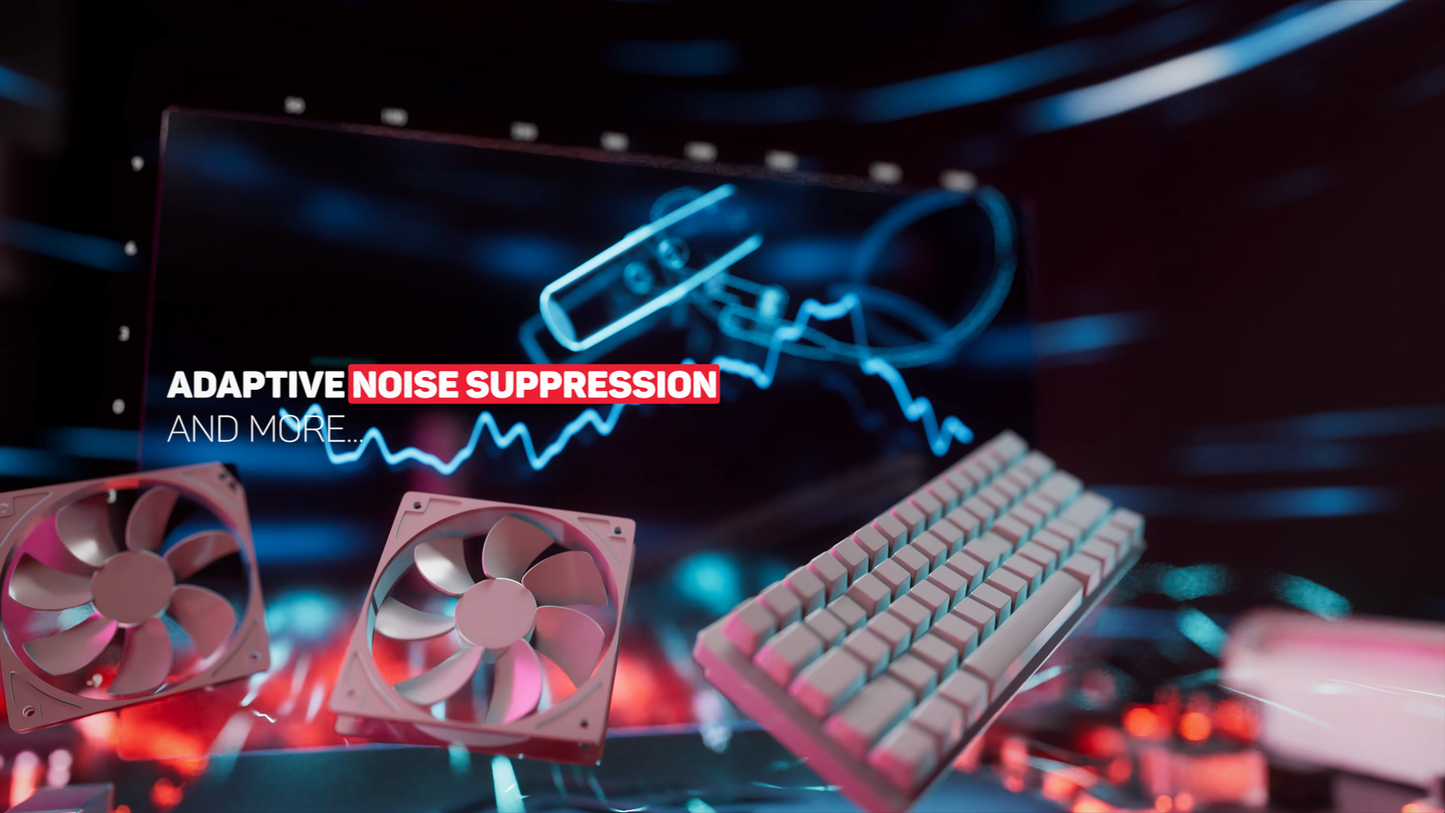
NOISE SUPPRESSION
Using our patented noise suppression algorithm made popular in BEACN Mic, we elegantly remove steady-state noise like fans, air conditioning, or your GPU getting hot and angry, from your mic. There are both adaptive and "snapshot" noise suppression modes to help fine tune things to your personal environment.
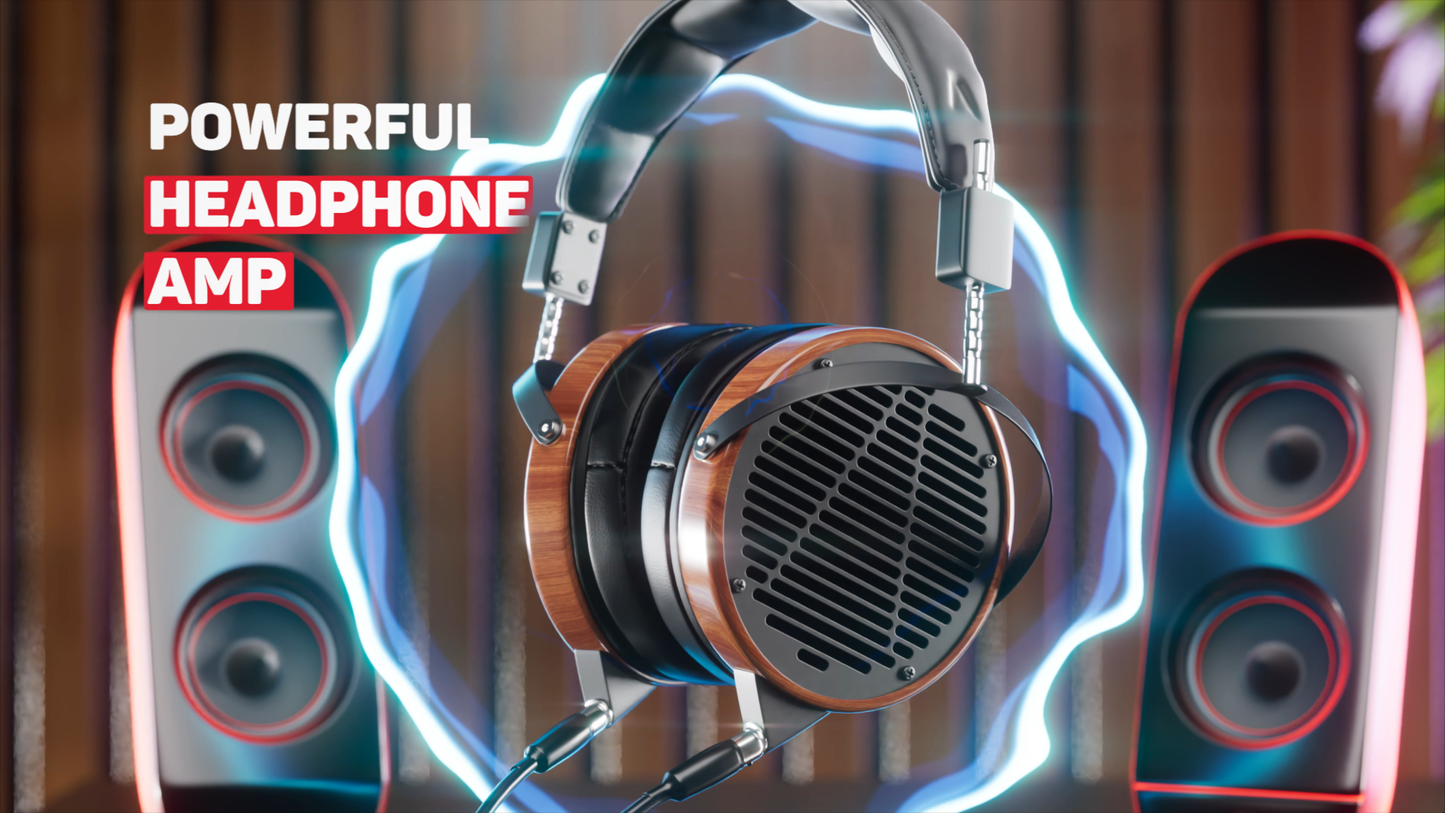
Powerful Headphone Amplifier
The best headphone audio starts with the best headphone hardware. Some of the top headphones are hard-to-drive with higher impedances, which isn’t an issue for BEACN Studio. Our Creator XLR Interface is equipped to give you the extra advantage. Whether you're listening through in-ear monitors or high-impedance headphones, BEACN Studio delivers crystal clear sound every time.
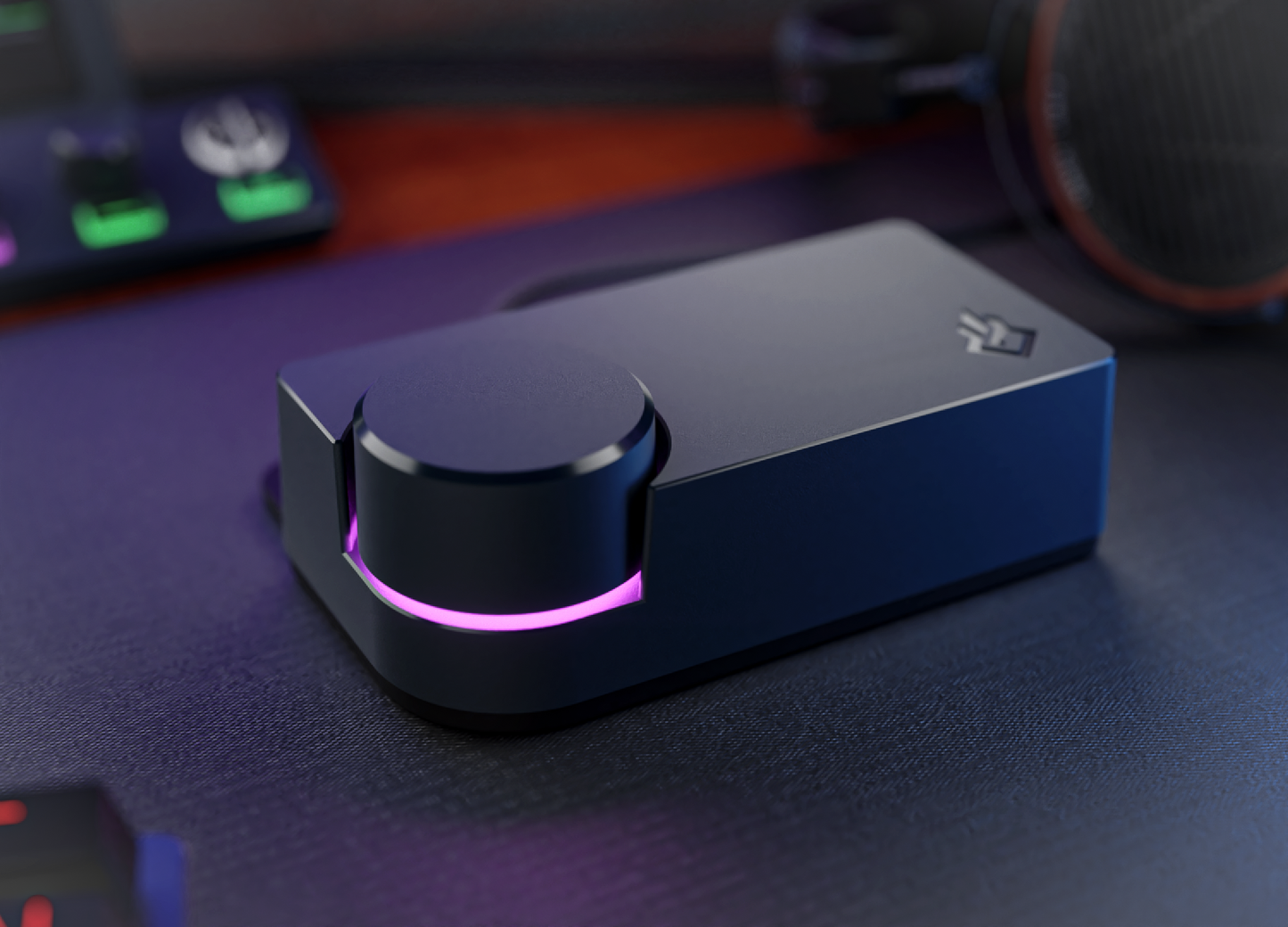
Made Just For You
Custom designed from scratch; every resistor, capacitor, inductor and other crucial audio component has been hand selected and placed to provide some of the best performance of any preamp on the market today, including gear you’d find in a high caliber recording studio. Go ahead, throw a scope on it. Our numbers don’t lie.

You Bring The Mic, We Bring The Rest
You’ve invested a lot in your microphone and we want to treat it with the respect it deserves. BEACN Studio enhances and expands everything available to you, without getting in your way with unnecessary complexity or desk space. We support virtually every dynamic or condenser XLR mic on the market today.

Let’s Get Together
You can do a little or go totally ham with our mixing suite. Paired with BEACN Mix Create you’ll gain access to even more controls and information to enhance your content creation workflow. If your mic could use a little support, definitely check out our sleek, low-profile BEACN Mic Stand!
Join our 40K+ beacn community
FREQUENTLY ASKED QUESTIONS
In some ways "it's exactly the same" is the right answer. There are XLR and headphone connections, a knob, and a USB output that connects to your computer.
In SO many other ways "it's very different from other interfaces" is also the right answer!
We built our XLR preamp from the ground up to power gain hungry mics like the SM7B or RE20. No Cloudlifter required.
Our headphone amplifier powers high-impedance headphones like Bayer Dynamic DT-990 Pro's.
Then we have an onboard DSP (digital signal processor) based suite of mic effects like EQ, Compression, De-Ess, Gate/Expande, Noise Suppression and more that you can hear in REAL TIME.
Add in our 2nd USB port that allows connection to a second PC for dual-PC streamers or a console like PS5 and we've covered a ton of content creator specific needs that not only help your technical setup but make your workflow easier too.
DSP is an acronym for "Digital Signal Processing".
We've put a DSP chip inside BEACN Studio that can process the signal to add much needed things like EQ, Compression, Noise Suppression and Noise Gate that help your mic to both suit your voice and the environment you're in.
Most audio interfaces simply turn your analog mic signal into digital and then pass it to your computer, requiring you to "process" the mic using various software tools once it has reached its destination.
Unfortunately, you can't HEAR what that processing is doing until you record and play back the signal in a trial-and-error process.
Our DSP is real-time, meaning the processed signal is sent directly to your headphones where you can hear it immediately with no latency.
That means that by the time your mic signal reaches the computer it already sounds great and you don't have to use up precious CPU cycles and your valuable time to get a good sounding output.
Yes and no.
XLR and USB in and of themselves are not better or worse than each other.
That said, most XLR microphones originated in the music/recording industry and had a fairly decent level of quality behind them.
USB mics hit the scene to provide a simpler way to connect a microphone to your computer. All of the conversion between the analog mic and the digital USB output were contained in the USB mic, so you didn't need a USB audio interface like you do with XLR.
But those products weren't made by "audio experts" like the XLR mics from the musical world, so they got a reputation of being lower quality.
In recent years, USB microphones have made huge leaps in quality and functionality, bring some of then (like our BEACN Mic) up to par with XLR mics and sometimes vastly extending functionality that creators, streamers and gamers need for their workflows.
BEACN Studio is XLR based because we recgonize the vast number of XLR mics on the market that might be best suited to your voice, or simply one you've already invested in.
Keep in mind that an XLR microphone that goes into a USB Audio Interface and then into your computer operates exactly the same from a physical and electrical perspective as a USB mic. It's the differences in overall quality and flexibility that you want to keep a close eye to find what works best for you!
Many streamers and creators find that the workload places on their computer to encode, process, upload and otherwise create the output that goes out live can significantly reduce the performance of that computer. That's especially important if you're gaming and want every FPS you can squeak out of your hardware!
In recent years, streamers have turned to using a completely separate second computer to handle the heavy lifting of getting the stream out to the world, leaving their "main" computer to focus on putting maximum performance into their gameplay.
This "dual PC" or "2 PC" setup then poses challenges for getting both video and audio from one computer to the other.
Video is typically a bit simpler through use of dedicated video capture cards, but audio has always posed problems due to limited inputs/outputs on various computers, coupled with "ground noise" issues inherent when connecting an analog cable between two electronic devices.
BEACN said to ourselves "there has to be a better way!" and figured out how to connect a second USB cable to the second computer, allowing digital transfer of audio from one to the other.
Once we figured that out, we took it a step further and decided to give 8 channels of audio in each direction, a first in the industry. That allows you to send separate game audio, chat mic, audience mix, stream alerts or really whatever you want back and forth between computers seamlessly.
It all integrates direcly into BEACN App and gives you full control of routing and mixing, almost like the two computers are one.
When we put dual USB connections onto BEACN Studio and set things up to send multiple channels of audio in each direction, we thought we had really nailed a new functionality that wasn't previously available... and we had.
But, we're always thinking of how creator/streamer workflow can be improved through us breaking new ground. So, we looked at our existing BEACN App, which lets you drag-and-drop applications onto a knob to control things, and said "why can't we do the same thing but remotely from one computer to another?
So we got to work figuring out how to send data along with our multi-channel USB audio. That allowed us to send signals to the operating system on the second computer to change the output of applications remotely, right from BEACN App.
It also let us SEE which apps are making sound on the second computer and bring those names into our BEACN App.
BEACN Link App is super simple. It doesn't have a UI or a bunch of settings. It simply installs some drivers on your second computer and then lives "in the tray" where it listens for audio on the second computer and then acts as the director of traffic for both audio and data between the two computers.
You just install and run BEACN App on your "main" computer and BEACN Link App on the "second" computer. That's it!
Interface Tech Specs
INPUT TYPE
XLR
INTERFACE
2x USB-C
GAIN
0 to 69 dB
MAX INPUT LEVEL (dBu)
17dBu @ 0dB gain
INPUT IMPEDANCE (kΩ)
3.5kΩ
FREQUENCY RESPONSE
20Hz to 20kHz
SIGNAL TO NOISE RATIO
115 dB (A-weighted, min Gain)
DYNAMIC RANGE
111dB (A-weighted, min Gain)
EQUIVALENT INPUT NOISE
-129dBu (unweighted, max gain, 150Ω)
PHANTOM POWER
48V, 10mA
MICROPHONE MODULES
- Limiter
- Compressor
- Equalizer
- Real-Time Noise Suppression
- Expander/Gate
- Enhancement Suite
Headphone Tech Specs
INTERFACE
3.5mm
MAXIMUM OUTPUT POWER
85mW into 33Ω
IMPEDANCE
310mΩ (calced)
FREQUENCY RESPONSE
20Hz to 20kHz
DYNAMIC RANGE
99dB @ 33Ω
Additional Information
USB Output
RESOLUTION & SAMPLE RATE
16/24/32-bit PCM @ 48/96kHz
32-bit float* @ 48/96kHz
*Float is not supported on all systems. Float will be converted to PCM where necessary.
What's In The Box
BEACN Studio
- Getting started guide
- 1.5m USB-C to USB-C cable
- USB-C to USB-A adapter
System Requirements
WINDOWS
- Windows 11
- 4GB RAM
- Built-in USB 2.0 port
